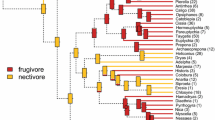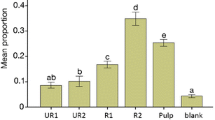Abstract
We have described the feeding behavior of the frugivorous butterfly Morpho peleides (Butler 1872) under various conditions and tested its ability to take up fluid from selected natural and artificial food sources in comparison with the nectarvorous Vanessa cardui (Linnaeus 1758). Both nymphalids showed similar probing behavior except for one particular proboscis movement and the fact that M. peleides was unable to feed from Lantana flowers. In 2-min feeding trials, M. peleides imbibed a greater amount of fluid from the food sources, with the most conspicuous difference on rotting banana. Without time restriction, M. peleides gained a significantly greater percentage of body weight from soaked plotting paper, whereas nosignificant difference occurred from tubular artificial flowers. The ability of M. peleides to feed more efficiently from wet surfaces than V. cardui is discussed in context with proboscis morphology.
Similar content being viewed by others
References
Alm, J., Ohnmeiss, T. E., Lanza, J., and Vriesenga, L. (1990). Preference of cabbage white butterflies and honey bees for nectar that contains amino acids. Oecologia 84: 53–57.
Bänziger, H. (1971). Extension and coiling of the lepidopterous proboscis—A new interpretation of the blood-pressure theory. Mitt. Schweiz. Ent. Ges. 43: 225–239.
Braby, M. F., and Jones, R. E. (1995). Reproductive patterns and resource allocation in tropical butterflies: Influence of adult diet and seasonal phenotype on fecundity. Oikos 72: 189–204.
Brakefield, P. M., and Kesbeke, F. (1995). Raised adult lifespan and female fecundity in tropical fruit feeding Bicyclus butterflies. Proc. Exp. Appl. Entomol. N.E.V. Amsterdam 6: 93–98.
DeVries, P. J. (1983). Morpho peleides (Celeste Común, Morfo, Morpho). In Janzen, D. H. (ed.), Costa Rican Natural History, University of Chicago Press, Chicago and London, p. 741
DeVries, P. J. (1987). The Butterflies of Costa Rica and Their Natural History, Vol. 1. Papilionidae, Pieridae and Nymphalidae, Princeton University Press, Princeton, NJ
DeVries, P. J. (1988). Stratification of fruit-feeding nymphalid butterflies in a Costa Rican rainforest. J. Res. Lepidoptera 26: 98–108.
DeVries, P. J., Murray, D., and Lande, R. (1997). Species diversity in vertical, horizontal, and temporal dimensions of a fruit-feeding butterfly community in an Ecuadorian rainforest. Biol. J. Linn. Soc. 62: 343–364.
Gilbert, L. E. (1991). Biodiversity of a Central American Heliconius community: Pattern, process, and problems. In Price, P. W., et al. (Eds.), Plant–Animal Interactions: Evolutionary Ecology in Tropical and Temperate Regions, John Wiley & Sons, New York, pp. 403–427.
Krenn, H. W. (1990). Functional morphology and movements of the proboscis of Lepidoptera (Insecta). Zoomorphology 110: 105–114.
Krenn, H. W. (1998). Proboscis sensilla in Vanessa cardui (Nymphalidae, Lepidoptera) functional morphology and significance in flower probing. Zoomorphology 118: 23–30.
Krenn, H. W., and Penz, C. M. (1998). Mouthparts of Heliconius butterflies (Lepidoptera: Nymphalidae): A search for anatomical adaptations to pollen-feeding behavior. J. Insect Morphol. Embryol. 27: 301–309.
Krenn, H. W., Zulka, K. P., and Gatschnegg, T. (2001). Proboscis morphology and food preferences in nymphalid butterflies (Lepidoptera: Nymphalidae). J. Zool. 254: 17–26.
Larsen, T. B. (1994). Fruit-feeding butterflies in large number on flowers. Entomol. Rec. J. Var. 106: 157–158.
Paulus, H. F., and Krenn, H. W. (1996). Vergleichende Morphologie des Schmetterlingsrüssels und seiner Sensillen—Ein Beitrag zur phylogenetischen Systematik der Papilionoidea (Insecta, Lepidoptera). J. Zool. Syst. Evol. Res. 34: 203–216.
Penz, C. M., and Krenn, H. W. (2000). Behavioral adaptations to pollen-feeding in Heliconius butterflies (Nymphalidae, Heliconiinae): An experiment using Lantana flowers. J. Insect Behav. 13: 865–880.
Pernstich, A., Krenn, H. W., and Pass, G. (2003). Preparation of serial sections of arthropods using 2,2–dimethoxypropane dehydration and epoxy resin embedding under vacuum. Biotech. Histochem. 78: 1–5.
Weiss, M. R. (1991). Floral colour changes as cues for pollinators. Nature 354: 227–229.
Young, A. M. (1975). Feeding behavior of Morpho butterflies (Lepidoptera: Nymphalidae: Morphinae) in a seasonal tropical environment. Rev. Biol. Trop. 23: 101–123.
Young, A. M. (1979). The evolution of eyespots in tropical butterflies in response to feeding on rotting fruit: An hypothesis. N.Y. Entomol. Soc. 87: 66–77.
Author information
Authors and Affiliations
Corresponding author
Rights and permissions
About this article
Cite this article
Knopp, M.C.N., Krenn, H.W. Efficiency of Fruit Juice Feeding in Morpho peleides (Nymphalidae, Lepidoptera). Journal of Insect Behavior 16, 67–77 (2003). https://doi.org/10.1023/A:1022849312195
Issue Date:
DOI: https://doi.org/10.1023/A:1022849312195




